Neon Genesis Evangelion: The Card Game

Neon Genesis Evangelion: The Card Game (新世紀エヴァンゲリオン カードゲーム), also known as Carddass is a collectable card game series that was first released by Bandai in 1998, with two main decks based on the original TV series and on the two movies (Evangelion: Death and Rebirth and The End of Evangelion) respectively. Both starter decks and supplemental packs could be purchased. Cards are divided into the categories Angel, Battle, Character, Drama, Instrumentality (補完; incorrectly rendered "Consummation" in the English fan translation), and Put. Nearly all cards contain a quote from the TV series/films and a small blurb of text pertaining to the Evangelion universe, related to the image on the card (usually a screenshot). The special Instrumentality cards have two sides, one of which features an original illustration by an artist from Gainax (Toshi Ishizaki, Shoji Saeki, Yusuke Yoshigaki, et al.). Bandai initially released a Carddass game in 1996, based on the anime alone, but soon followed with editions based on 1997's End of Evangelion and even videogames like Second Impression. The Carddass games in Japan exist since 1988 and are sold in vending machines as "information sources". Initially those were intended for children's education,[1][2] but would also cover a variety of media franchises,[3] starting with the Saint Seiya franchise.[4][5] As of March 2021, Bandai Namco has sold 17.767 billion Carddass cards since 1988, in addition to 2.749 billion Data Carddass cards since March 2005.[6][7][8][9]
The relevance of the card texts to Eva interpretation have been criticized and defended. It should be noticed that Cardass was released in 1996 and is thus one of the earliest known sources to provide information on several things. It's understandable they might seem dubious at first as they're not a guidebook proper. However, it's clear they're a sort of informational material and not just a game contained to a separate continuity: unlike material for videogames and spin-off manga, their descriptions concern themselves strictly with canon events, and not any "what-if" or alternate scenarios. They match more comprehensive later sources like the Red Cross Book and even later ones like Evangelion Chronicle verbatim in many cases, and differing slightly in others, as is usually the case with Evangelion supplemental material. Because the game is sold as supplemental material to the series, and there is nothing speculative or alternative present in its descriptions, it can be considered solid Tier 2 Canon, much like the Classified Information from the Neon Genesis Evangelion 2 videogame, with the "gameplay" side kept separated in both. They might thus be seen as effectively official guidebooks in card form.
How It Works
Before the game begins, each player must choose 30 cards to use for their deck, ala Magic the Gathering. More than 30 cards can be used, but one angel must be included for every 15 cards in the deck. The cards are then shuffled and placed in front.
The first thing you do is choose a Level 1 Consummation card. A Consummation card is a specific goal related to a character that must be achieved before going onto the next stage and/or winning the game. Place this card face up in front of you. Next, the 6 character cards are placed in a pentagon formation (henceforth called Neo-Tokyo), starting from the top moving clockwise: Gendo, Ritsuko, Misato, Asuka, Rei, and Shinji placed in the center. Place the 3 Evangelion cards beneath Neo-Tokyo. Six cards are then drawn by each player to form a hand. Determine who will go first by playing the ol' method of Rock-Paper-Scissors.
Phases
The game cycles through six phases in a single turn sequence of play. They are as follows:
- Open Draw Phase: Draw one card from your pile. If it's an angel, place it in Neo-Tokyo immediately.
- Battle Phase: Done only if an Angel is in Neo-Tokyo. The Evangelions will attempt to defeat the Angel.
- Main Phase: This is where you control the relationships of Neo-Tokyo. Here, you can hurt or attract characters by using Put cards or Line Cards. (See the Cards section for more information)
- Ending Draw Phase: Everyone totals the draw points (DP) on the cards they played this turn and draw cards from their deck accordingly, or discard from their hand accordingly.
- Consummation Phase: All players check their consummation requirements. If met, the player upgrades to Level 2. If Level 2 is completed, the player may declare a Consummation Stage. (see Consummation Stage below)
Cards
The basic anatomy of cards are as follows. The top left states what type of card it is. The top right +/- number is the draw point number used for the Ending Draw Phase. The center body is fairly straightforward as it explains the card effects. The bottom contents of the card relates to the Line Card, which is explained below.
The different types of cards:
- EVA Cards: These cards are used principally to fight the angels. If the corresponding pilot is downed (flipped over) in Neo-Tokyo (see Line Cards), then that Evangelion cannot be used. They can only be spoken (played) in the Main Phase.
- PUT cards are literally put onto a character or Evangelion card and include a variety of events or rule changes to the game. No more than two may be placed on any character. They may only be used in the Main Phase.
- BATTLE Cards can only be used in the Battle Phase of the Turn Sequence.
- DRAMA cards refer to the unfolding events surrounding Neo-Tokyo and its 6 main characters. They can be used in the Opening Draw Phase and the Main Phase. Their effects only last 1 turn, however.
- LINE cards are used when all cards other than consummation and angel cares are turned upside down. Line cards are used to hurt or attract characters in Neo-Tokyo. Here, a line is spoken aloud by the player and the character is either attracted to another character/character group, or is downed. The geometric symbols underneath the line are called Line Marks and they indicate if a character can be attracted or hurt. Triangles represent hurt and circles represent attract. The color of the triangle or circle reflects the color of the character card. Players can choose only one Line Mark per Line Card to use on a character. Each line card is worth 1 DP, except those spoken by Rei Ayanami, which are worth 0 DP. Line Cards can only be spoken in the Main Phase by the active player.
- ANGEL cards are of course the enemies of the game. Each angel has a given strength, represented by a number on the lower right of the card. To defeat an angel, the total strength of the Evangelions must exceed the strength of an angel. A tie in strength will result in a defeat for the Evangelions.
Consummation Stage
The main object of the game is to reach the objective as listed on the consummation cards. There are 2 levels of these. Once the second level is passed, the player may call a Consummation Stage (but doesn't have to). This can only be done at the Consummation Phase during the active player's turn.
This Stage works as follows. Only Line cards are used. The object is to attract the character corresponding to the character on the consummation card. Other non-active players may hurt the character in response, but if they do not react during this first counter-attack, they will not be able to play a line card for the rest of this stage. As the Stage progresses, if the active player plays a Line card that attracts, but is not countered by any Line card that hurts, the active player wins the game.
Translations
- Bochan_bird: Part II (movie) card A-17 "2nd Angel Lilith":
"A Source of Life Angel called/named 'progenitor' like
Adam. Until being noticed by Nagisa Kaworu, Nerv had misrepresented the giant crucified in Terminal Dogma as Adam, but it was actually Lilith. Ayanami Rei is a being with the soul of this Lilith and (a copy of) the body of
Ikari Yui."
- Bochan_bird, Put card P-R1:
"All life was drawn indiscriminately into the world desired by the
medium/avatar Shinji. Led by the Reis -- the messengers of salvation -- hurt and suffering hearts dissolved into homogeneous LCL. Even those who did not wish salvation were powerless to resist. Aoba frantically rejected Rei, but the A.T.Field that protected him had already lost its
power."
- Bochan_bird, Drama card D-88; "Kimochi warui":
"Shinji renounced the world where all hearts had melted into one
and accepted each other unconditionally. His desire... to live with 'others' -- other hearts that would sometimes reject him, even deny him. That is why the first thing he did after coming to his senses was to place his hands around Asuka's neck. To feel the existence of an 'other'. To confirm (make sure of) rejection
and denial."
- Card H-11
- Regular side, picture description: "What we see is the aftermath of Third Impact, like in the ending sequence, there is Shinji standing (dressed in his school uniform), his hand, palm up, in front of him, and he's looking at (and casting his shadow upon) an unconscious Asuka, laying of the ground in an unconscious-but-also-inviting-and-somewhat-surrendering pose, her home attire messed up so that all what was visible of her in the original scene is there for Shinji and the viewer to see." Bochan_bird translation:
"In the sea of LCL, Shinji wished for a world with other people.
He desired to meet them again, even if it meant he would be hurt and betrayed. And just as he had hoped/wanted, Asuka was present in the new world. Only Asuka was there beside him. The girl who he had hurt, and by whom he had been hurt.
But even so, she was the one he had hoped/wished for...."
- Reverse side:"3rd Children Ikari Shinji":
"Neither Yui, Rei nor Misato could do as a woman for Shinji.
Asuka alone was the only girl on equal footing with him. So, Shinji desired/sought after Asuka. "I'm afraid of Misato and Ayanami." However, Shinji's crude affection only hurt her. In the end, he used her as an object of lust/desire to soothe/
console himself..."
- Bochan_bird, card H-14;
- Regular side: Misato & Shinji EoE kiss
"3rd Children, Ikari Shinji -- Misato monitored him in her capacity
as Nerv Tactical Operations Chief. Monitoring in the format of living together, a format that would not agitate him. Play acting, searching for a comfortable distance, clashing, rejecting, worrying, joking, fighting, and understanding. The apartment changed from
a simple dwelling to a home..."
- Gold side: Shinji and Misato dressed up and sharing cocktails in a club. Title: "That's a grownup kiss. We'll do the rest when you get back."
"While fighting the Angels together, the two began to view each other not just as Tactical Operations Chief and pilot, but in a special way. Older sister and younger brother, mother and son, girl and boy... but the two did not notice/realize the word used to express these feelings (this relationship?). However, time would teach them, just as it had fostered the relationship between them."
- Miscellaneous:
"Card H-2 shows Shinji in his plug suit facing Gendo (back view). The title is "I was praised by my father/My father praised me", and the fine print reads: "'You did well, Shinji.' -- Gendo praised Shinji, who had piloted Eva. Shinji, who had avoided and rejected his father, realised how much he needed/wanted his father. At the same time, Gendo was also coming to understand a sense of (comfortable) distance with his son. As father and son move toward each other, however slow, perhaps one day...." This is perhaps the most ambiguous of the three cards, but it is still a far cry from "Shinji reconciles with Gendo"."
"Card H-5 shows Rei and Shinji facing each other with the moon in the background. The title is "This is my heart? I want to be one with Ikari-kun?" (Ep23 dialog), and the fine print reads: "As the scenario progresses, he changes her. A smile, worrying, words of thanks... Eventually, with her first tears, she realizes. 'I want to be with Ikari.'" Not only does this describe the TV series scene perfectly, but I hardly think it qualifies as "Rei gets Shinji".
"Card H-12 shows Asuka hugging someone whose face is cut off at the top of the image and thus cannot be seen. This person might be mistaken for Shinji, except that the relative size of the person obviously makes it an adult, and the card deals with Asuka waking up in Eva-02 at the bottom of the Geofront lake (EoE scene) and realizing that her mother is there and has always been watching over her."
| Gallery | |||
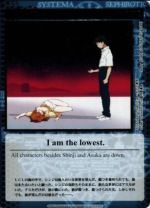 |
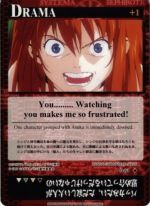 |
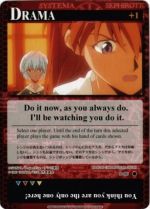 |
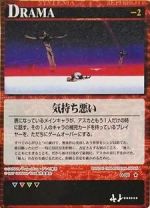 |
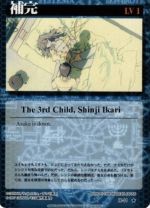 |
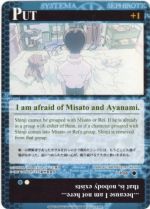 |
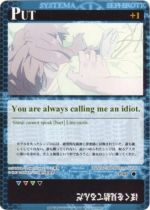 |
|
Notes
- ↑ Bandai website
- ↑ 30TH ANNIVERSARY MINI CARDDASS VENDING MACHINE [Jun 2020 Delivery
- ↑ Example for a Gundam Carddass collection
- ↑ Carddass: Saint Seiya - Reborn Saint Paradise - Crash! Proud Assassin
- ↑ Carddass on Yu-Gi-Oh wiki
- ↑ Cardass Wikipedia page
- ↑ French Evangelion Fandom Wiki
- ↑ Bandai's "Carddas" topped the total sales volume of 10 billion pieces
- ↑ BANDAI BRINGS 'BATTLE SPIRITS TCG' TO U.S.
